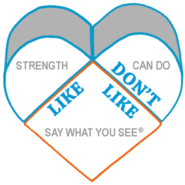Removing Judgment—A Simple Exercise

This really happened:
SAY WHAT YOU SEE (SWYS): “You are biting my shirt.”
(I didn’t like that.)
CAN DO: “That’s not OK with me. Must be something else you can bite. Hmm. Here, you can bite this!”
I offered the child the hem of his own shirt. He looked at me, grinned, then bit his own shirt. He walked around with his shirt in his mouth for a few minutes, then was done.
SWYS: “You bit that until you were done.”
(I liked that.)
STRENGTH: “You like biting cloth. You knew what you needed and found a way that worked!”
The Language of Listening® coaching model always starts with one thing:
- First SAY WHAT YOU SEE® to connect with children.
- When you see a behavior you LIKE, add a STRENGTH.
- When you see a behavior you DON’T LIKE, add a CAN DO.
“Like” and “don’t like” are coaching boundaries. They tell you which way to go when you move from the step of connection (SAY WHAT YOU SEE) to the step of guidance (STRENGTH or CAN DO) to facilitate personal growth.
If staying calm and coaching children like this is hard for you, it may be because you don’t see things in terms of what you like or don’t like, but rather in terms of good or bad.
Good/bad are judgments that were taught to most of us as children and are loaded with shoulds like these: you should do this, not that; you should be good, not bad. “Doing” translates to “being” in children’s minds, so heaven forbid that you would want to “do” something your parents decided was bad because then you would “be” bad.
“Bad” as a judgment feels bad to you and to your kids, which is why setting boundaries based on good/bad can make staying calm very difficult.
Like many shoulds, “good” and “bad” are learned and become external forms of guidance. “Like” and “don’t like” are internal. They come with your unique package of being human.
But when you are trained to ignore your internal guidance and replace it with external shoulds, your awareness of your internal compass weakens and can leave you confused about when to act or not, and what boundaries to set.
I’ve met more than one parent who thought they didn’t have any boundaries at all, though there were plenty of things happening around them that they didn’t like.
One parent in particular was delighted when I helped her discover she actually already had a boundary. She would put up with her young child hitting her because it didn’t hurt, but when it did, she got angry and stepped away immediately. She had somehow learned that hitting was OK until it hurt, at which point it became “bad” and warranted a boundary.
Once she realized she actually had a boundary that she wouldn’t allow anyone to cross (hurting her), she tried setting another and another. Over time she was able to train herself to recognize things she didn’t like sooner so she could set boundaries well before situations got “bad.” She feels like a completely different person now, and so does her child.
Check this for yourself. Do you worry about what other people think more than how you feel when you are setting a boundary? Are you concerned about your choices being “good” or “bad”? Are you afraid you don’t have any boundaries at all?
See if this helps take the heat out of boundary-setting:
Beyond being learned, “good” and “bad” are highly subjective.
What is good for one person may be bad for another. Good/bad are value judgments that change based on the situation and the outcome.
An ancient Taoist folktale demonstrates this beautifully. Here is the version told by Anthony de Mello in Sadhana, a Way to God, (Random House, 2011) p. 140.
There is a Chinese story of an old farmer who had an old horse for tilling his fields. One day the horse escaped into the hills and when all the farmer’s neighbors sympathized with the old man over his bad luck, the farmer replied, “Bad luck? Good luck? Who knows?”
A week later the horse returned with a herd of wild horses from the hills and this time the neighbors congratulated the farmer on his good luck. His reply was, “Good luck? Bad luck? Who knows?”
Then, when the farmer’s son was attempting to tame one of the wild horses, he fell off its back and broke his leg. Everyone thought this very bad luck. Not the farmer, whose only reaction was, “Bad luck? Good luck? Who knows?”
Some weeks later the army marched into the village and conscripted every able-bodied youth they found there. When they saw the farmer’s son with his broken leg they let him off. Now was that good luck? Bad luck? Who knows?
Note: The “May be” version of this can be found in Tao: The Watercourse Way by Alan Watts, (Pantheon, 1975) p. 31.
Not only are “good” and “bad” subjective, they are a form of social agreement, which is why it makes sense that when setting a boundary with your child or another adult, you might still look around to check what others think. After all, as a child, something you thought was good (like playing in the mud or with your food, etc.) could easily have been bad according to your mother. Checking with others is a hard habit to break, until you reconnect with your inner compass.
When you recognize that “like/don’t like” are actually your solid truth, all you need to do is look inward to check.
At that point, boundary-setting becomes more like boundary-claiming. It’s already there, and you are just pointing it out as in, “I don’t like that. That’s not OK with me. Must be something you can do that works for us both.”
When your boundary is just true, not a judgment or criticism of others, you can claim it without heat. Calm cool boundary-setting is possible when you trade “good/bad” for “like/don’t like.”
Simple Exercise:
This week, try switching “good/bad” to “I like that/I don’t like that” in your everyday conversations with your kids, other adults, and yourself, and let me know what you discover.
2 Comments
Trackbacks/Pingbacks
- Boundaries, Family Rules, & Strong-Willed Children... Oh My! - […] Read: Removing Judgment From Behavior (How To) […]






This is genius!
sandy, I just found you. I can feel how important your work will be on my life and in my relationship with my son. I am so grateful for the work that you have created. Thank you so much.